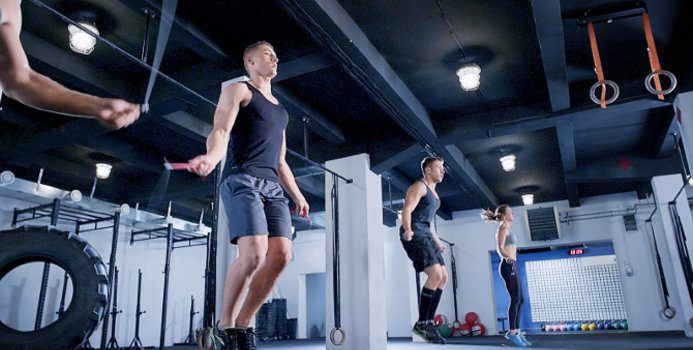
The best online fitness resource you'll ever need. We filter out the BS to ensure you meet your health and fitness goals!

The best online fitness resource you'll ever need. We filter out the BS to ensure you meet your health and fitness goals!

Circuit training can elicit fantastic results in a very short space of time for those looking to boost their cardiovascular fitness, workload capacity, and explosivity, and for those looking to build and maintain a caloric deficit in order to lose weight.
There are some good uses to which circuit training can be put. They are times in which it is highly relevant. There are also some downsides to it – there can be times in which, and people for whom, circuit training may be inappropriate.
Circuit training is a combination of exercises performed with short rest periods between them, in short. Typically, there are six or more exercises, though this needn’t necessarily be the case. Each exercise is performed concurrently, in order, to a set rep range or amount of time.
When one round of these exercises has been complete, this represents one ‘circuit’. There will also typically be a set number of circuits to be performed, with multiple occurring through a training session.
There is generally a set rest period between each circuit, sometimes with a rest between each exercise.
Exercises will generally be set up for a short duration and with a low enough level of stimulus that they can all be performed with good technique after little rest – it would be rare, though not unheard of, to include a one rep max squat or deadlift in a circuit!

This makes circuit training a very time efficient way in which to improve cardiovascular fitness and muscular strength endurance. It would be very reasonable to see around 40 sets in an hour-long circuit, with potentially dozens of reps of any given exercise in any given set.
Circuit training will also always be structured so as to maximise heart rate. It should realistically be performed mostly in the 85%+ ‘Orange Zone’, thus eliciting afterburn. This will be achieved partly through timing – stringing so many high-rep sets together in such a short amount of time should elevate your heart rate.
Exercise selection also plays a part. Circuit training flourishes with large, explosive compound movements and core exercises. You will be likely to see plenty of push ups, squats, lunges, burpees and walk outs; less so biceps curls and leg extensions!
Structure in this exercise selection should also be well-thought out in a circuit. It should be structured so that you can move from exercise to exercise without form breaking up from excessive fatigue.
For example, rather than going straight from squat jumps to burpees to lunges, which all tax the legs heavily, you might break it up with push ups, pulls ups and planks, which predominantly focus on the torso and core. Bodyweight exercises will also play a large part in circuit training exercise selection.
There are plenty of ways in which to structure a circuit. In fact, you may sometimes want a purely lower body one, or purely core one, if you’re really looking for endurance.
However, as a basic, catch all template, the following will work incredibly well. It will allow you to work your full body, without much by way of over-fatiguing or breaking down in form.

We’ll use an eight-part circuit, covering the basics of upper body, lower body, full body, core and heart rate boost. It should look something like this:
So, we could structure a circuit training workout as follows.
We will do four circuits of eight exercises, with a two-minute rest between each one. Each exercise will be performed for 40 seconds, with a 20 second rest between each, which should be enough time to set up for the next exercise.
This means that each circuit, with a rest, will take ten minutes. The whole thing should therefore take forty minutes.
The circuit will be as follows:
You will work every muscle in your body to a greater or lesser degree, whilst maintaining a very high heartrate and improving muscular and cardiovascular endurance. This will all be done in forty minutes – an incredibly efficient way to train.
Circuit training has many benefits. Primarily, from a lifestyle point of view, it is good for people who get bored training or who have limited time, as it is so time efficient – you can get an awful lot of work done in very little time. It also doesn’t need much by way of equipment if you don’t want it to. For example, this short circuit uses nothing but body weight:
Switch the sprint for squat jumps or jumping jacks and it can be performed with barely any space needed – you could easily do it in your living room.
In addition to these practical considerations, there are some distinct biological benefits to be gained from circuit style training. These include:
Using such large amounts of muscle mass in such an intense way will spike your heart rate. As mentioned above, it should reliably stay in the 85%+ Orange Zone throughout most of a circuit.

This is because your heart is having to work harder to pump the increased amount of oxygenated blood your muscles need around the body. Doing so will improve your cardiovascular fitness very quickly.
This is minimal in more seasoned athletes. However, for intermediate athletes, the compound exercises used should improve muscular strength. Most likely, your ability to perform moves like squats, push ups and ab stability and strengthening exercises will increase. This will plateau at a certain point, but it’s a good initial benefit.
This is the main muscular benefit to be had. You should always be able to adapt your workouts to push yourself and take you to overload, no matter how experienced you get. This means that you will always be testing and improving your muscular endurance.
There are two elements to the energy burn from circuit training.
The first comes from the sheer effort involved in completing a session. The types of movements used, the rapidity, and the volume all make for a taxing workout in which several hundred calories should be burned per hour.
The second comes from the aforementioned ‘afterburn’. Essentially, your body goes into a heightened metabolic state for 12-48 hours post training after this kind of workout. You will burn more calories at rest than you usually would.
For both these reasons, circuit training can be a great tool for weight loss or maintenance.
However, circuits are not perfect. Nor are they relevant for everybody. For instance, it isn’t ideal for beginners, for whom the intensity and complexity of the movements can be overwhelming. It’s also often touted as a cure all, perfect style of workout – it isn’t. No exercise system is. There are some areas in which it falls down.

This all being said, there are some common disadvantages to circuit training that any athlete should bear in mind:
Circuit training is not good for building strength. Once you can perform a few bodyweight squats and a few push ups, you will likely find that the strength benefits to be gained dwindle.
Though hypertrophy and muscular endurance can continue to build, total strength cannot be. As mentioned above, you are unlikely to see a 1 rep max squat in a circuit session.
Circuit training can take up a lot of room (though, as above, it doesn’t strictly always need to.) Circuits include several bases, many of which will have their own equipment.
Many common exercises, such as runs, walking lunges and carries, require a lot of room for manoeuvre.
If you train in a class, this should be OK – the instructor will account for it. If you train at peak time on the gym floor, however, you are unlikely to be able to get the space you need.
Exercises like push ups, pull ups and squats take time to learn and perfect. They actually include a lot of specialised technique that needs to be learned in order to execute them safely and efficiently.
Circuit classes will let you practice the skills needed, at length, for many reps. It won’t teach good form, though. You will need to come to it with decent form already in place. Otherwise, you will just be drilling poor technique. You could end up getting hurt.
This is its main benefit. However, the demanding nature of circuit training makes it deeply inappropriate for many people. If you have high blood pressure, cardiovascular problems or breathing difficulties, for instance, it is likely a non-starter.
Similarly, if you have a low level of fitness, it should be avoided. Try gentler forms of cardio and resistance training, like walking and light, single set weight training, until you are ready for the challenge.

As you can see, circuit training is an amazing tool and resource. If you want to improve your muscular endurance, lose weight whilst maintaining muscle mass, or simply get a decent workout in without spending hours on it, it could be everything you need it to be.
Just make sure that it is appropriate for you – don’t expect to learn good form or improve your strength in a circuit class, and don’t expect to be able to safely keep up with the brutal pace if you’re a first timer.